I love jewelry but when the proprietor of a local military surplus store asked, “Want to see some WWII Sweetheart jewelry?” I responded, “What’s that?” Since you’re reading this blog, you may be much better informed than I was about the incredible variety of jewelry that was created during the war and given to loved ones. An excellent introduction to Sweetheart Jewelry can be found at http://antiques.about.com/od/historyandinformation/a/aa110899.htm?rd=1
WWII Sweetheart Jewelry was made by local craftsmen, jewelers, even servicemen in the trenches using whatever materials were at hand. Quite of bit of the jewelry is sterling silver but there are also pieces made of gold, aluminum, and pot metal among other things. There are even some great bakelite items but they are rare and expensive.
WWII Sweetheart Jewelry – ear rings
As it turns out, I purchased a fascinating pair of WWII earrings at an estate sale years ago without knowing their significance. As you can see the earrings are made from Mercury Head dimes minted in 1925. The maker used acid to etch out the extraneous material, leaving only the word “Liberty”, the mint date, and the head. I bought them because I thought they were cool.
WWII Sweetheart Jewelry – lockets
I’ve since seen pendants made from Mercury Head dimes, but my earrings are the only example of acid-burned dimes I’ve found. I always get interesting comments when I wear them. I purchased the sterling silver locket pictured below from the owner of the military surplus store after she explained its significance. The locket opens allowing one to insert two small photographs or a lock of hair or other memorabilia. The thing that I found fascinating and unsettling is the decoration on the locket – two crossed rifles signifying the infantry. This locket was originally purchased in Australia during WWII.
Crossed rifles are a common decoration in Sweetheart jewelry. I found this sterling silver pin and locket at an antique store in McPherson, Kansas. Note that the guns in the locket pictured below are different from the guns displayed in the locket above.
This locket isn’t hinged. It opens by sliding the front and back pieces in opposite directions. Crossed rifles weren’t the only gun-related items depicted in WWII jewelry. Real or artificial ammunition was also frequently part of Sweetheart jewelry. Check out Byron Roche’s collection at http://www.byronroche.com/sweetheart.html. His web site shows a pin that Roche identified as a replica of a P38 made from the shell casings of 50 caliber machine gun bullets. He also has a belt buckle made from smaller bullets.
WWII Sweetheart Jewelry – pins
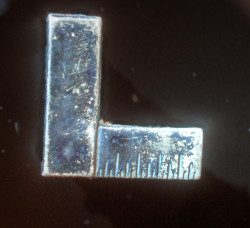

The two interesting pins above were worn by US troops during WWII and appear in books about Sweetheart jewelry. The sterling silver pin at the top, a little smaller than a quarter, is a replica of a square. It may have belonged to a Seabee or a member of the Corps of Engineers. Below is a paratrooper pin which is also sterling silver. As you can see, it has a gold patina. A similar pin on ebay, was identified as a “US Army Airborne Paratrooper’s Jump Wings qualification badge pin.”
The winged pin below wasn’t worn by US troops but by civilians who were members of the GOC – Ground Observer Corps. The pin reads “United States Air Force Supervisor GOC” which was composed of civilian volunteers who watched for enemy aircraft along the U. S. coastlines. (http://www.radomes.org/museum/documents/GOC/GOC.html)
In-Service pins, also called mother pins or blue star mother pins, may have been the most common of all the WWII Sweetheart jewelry. The pin, like the banner hanging in the front window of a family home, signified the number of family members serving in the military. I have two In-Service pins, one a small, rectangular pin with a single blue star on a white background with a red border, and the other a sterling silver pin with the single star, but attached by a chain to a pin with wings and a single propeller.
The pin on the left was worn by a family member with a loved one serving in one of the branches of the US military during WWII. The star pin on the right, which is close to its actual size, would have been worn by someone with a loved one serving in the US Army Air Force or a pilot in the US Navy. In-Service pins with two or more stars exist but they are rare and expensive. (Note that the two silver attachments sticking out from the left side of the one-star pin are not part of the pin. They were used by the photographer to hold the pin upright.)
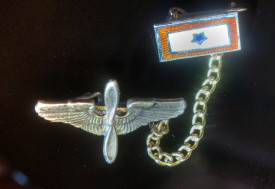
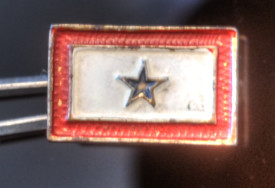
Pins made especially for mothers from mother-of-pearl were frequently purchased by US service men and women who then mailed the pins home. My great aunt, Ila Armsbury, purchased the pin shown below for her mother, Florence. I found it in my grandmother Wava’s jewelry box after Wava’s death in 2004. The word “Mother” appears to be made of brass as is the back of the pin.
WWII Sweetheart Jewelry – compacts
Sweetheart compacts were also common during the war, given as gifts to wives, mothers, and girl friends. The compact pictured below represents the US Army Air Force with the Army insignia centered on the face of the compact and the blue background signifying the Air Force. You can tell from the wear on the face of the compact that it was frequently used.
WWII Sweetheart Jewelry – a piece I’d like to have
One piece of Sweetheart jewelry I don’t have but would like to find is a WWII RN caduceus pin to represent Ila’s contribution to the war effort. I’ve seen one with the letters “PN” and one with “LPN” so I’ll keep looking for one with “RN”. I have one of a pair of caduceus cufflinks (I know it’s a cufflink because it has a screw back) but don’t know whether it’s from WWII or the Korean War and there is no identifying mark to help me figure it out. As you can see, this cufflink is quite worn.
WWII Sweetheart Jewelry – rings
My last piece of jewelry to share with you, and the my most treasured, is a sterling silver ring that Ila purchased for herself while she was in Australia. It has her initials, IA, engraved in the middle of the puffy heart. Stamped on the underside is the word “Australia” and this: “D:IMK GEOR”
(The photographer is using a special apparatus to hold the ring upright to display the heart and Ila’s initials.)
I have no idea what the letters mean although I think that GEOR may be short for George. If anyone knows what “D:IMK” stands for, I’d love to hear from you. I’ve looked briefly for Korean War Sweetheart jewelry but the few items I’ve seen on the internet can’t be dated exclusively to the Korean War. Some of the items are probably from WWII, and some are from the Viet Nam era.
If you decide to start collecting Sweetheart jewelry – with WWI and WWII jewelry the most readily available – consider purchasing Nicholas D. Snider’s excellent book Antique Sweetheart Jewelry, published in 1996 by Schiffer Publishing Ltd., Atglen, PA. This paperback book is full of historical information about Sweetheart jewelry from both WWI and WWII as well as pages of colorful photographs and a price guide. Remember the publication date was 1996 so prices have increased. In spite of that, I’ve found the price guide to be very helpful when I’m bidding on an item on ebay or another internet auction site. Happy hunting!



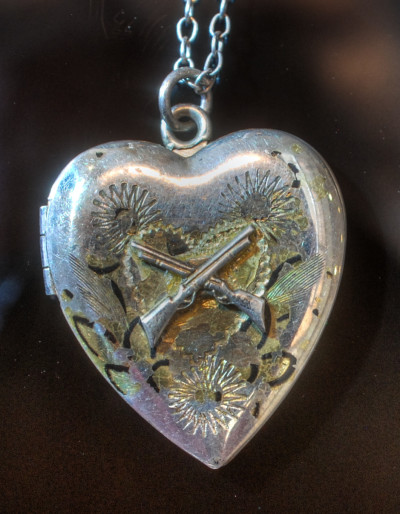
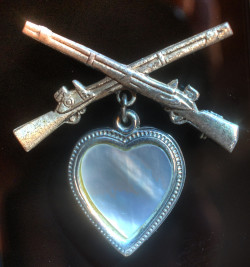
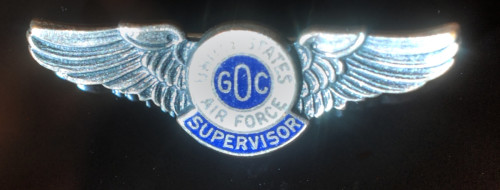
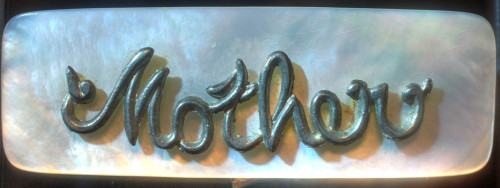
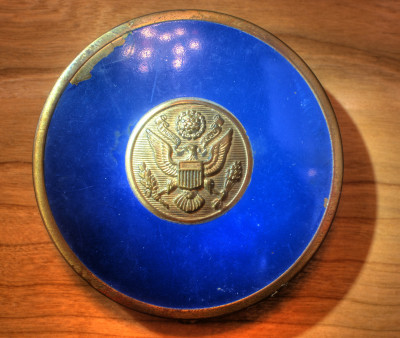
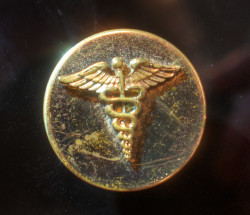
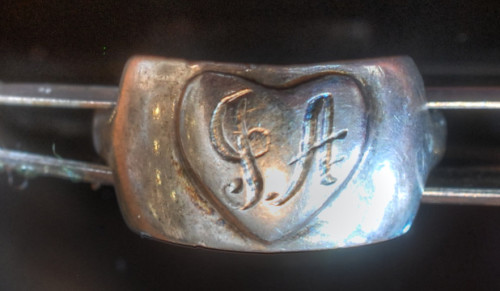
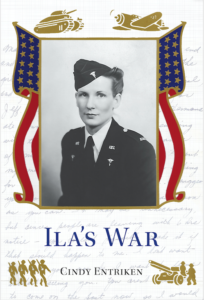
this is interesting. in world war !! my father was stationed as a merchant marine in Murmansk. He made me a necklace out of Russian coins. I’d forgotten all about it until I read your blog. Thanks! Your website has interesting articles and will help launch your book.
good luck. continue…Maria
Maria, thanks for the email. It’s good to hear from you. You might want to goggle WWII Sweetheart Jewelry. You’ll see several examples of bracelets made from foreign coins. Sometimes there are also examples of foreign coins used to make rings and necklaces. WWII Sweetheart jewelry also provokes lots of comments from observers who see it being worn. I always get great comments when I wear my Liberty Head dime ear rings. Wear your bracelet in good health! Cindy
I will enjoy seeing your blog and hiistorical info you and
others share. Although I did not appreciate my great aunt as a child. since then I have valued her experiences as a history prof and traveler.. History is fascinating. So much is gone….
These are all lovely! Would you happen to know how much the locket with the rifles would be worth?
Amy, sorry to be so slow in responding. I don’t know how much the locket is worth. If you have something similar you will want to talk with someone knowledgeable about Sweetheart jewelry like a Military Antique store in your area. Where are you from? There is a good store in Leavenworth, Kansas. A regular jeweler isn’t going to know the value – he/she can only estimate value based on weight but won’t be able to consider the historical value. You might also look on-line and see if you can find a WWII web site that sells Sweetheart jewelry. Remember if they offer you money, it will be for less than the value of the item because they will want to make a profit. Sorry I couldn’t be more helpful.
This may explain the details you have on your ring.
This is the Latin used on the Australian Florin coins during WW2.
GEORGIVS VI D: G: BR: OMN: REX: F: D: IND: IMP. The lettering on your ring may be the remnants of the original mintage details. Most rings were fashioned using these coins during that period.
Lawrence, thank you for taking the time to provide such a detailed explanation. There’s much to learn about sweetheart jewelry and I’m always interested in knowing more.
Hi, just ran across your page. I am a military antiques dealer and avid collector of sweetheart and home front jewelry. I believe the pin that you have shown as a cuff link might be misidentified. From the picture it looks like an enlisted uniform collar brass disk for a WW2 army uniform. It could be screw back or clutch back. You will also find officer’s insignia that is not a disk but a stand alone emblem, not on a disk.
I’ve been collecting for quite awhile and love sweetheart pieces. Once you get started it becomes quite addictive.
Thank you for the correction. I admit to being a novice regarding Sweetheart Jewelry. You are absolutely right that collecting can be addicting. I don’t have the storage space to collect everything I see, so I am trying to be more selective about the jewelry I purchase. Alas, some of it just calls to me!
Hi Cindy-
Your page is a great historical service. I have a small ring, looks like a signet, that includes a five pointed star in the middle on a white background with a red border. On one side it says US and has crossed infantry rifles. On the other side is a golden eagle. I don’t think it is gold. The back is stamped with a patent mark. I wonder if the ring has value or use to any collector. Or if I should just give it to a little girl to wear and have fun with. Glad to send a photo if you want. Thanks, Howie
Howie, thank you for the very kind words. I have enjoyed the blog and the research a lot and will continue, especially when I get such positive feedback. If you’ll email me a photo I can look in my book of sweetheart jewelry and see if I can find anything similar. My first thought was that your ring reminded me of one my grandfather wore, a ring which signified his membership as a Shriner. But I’m not sure at all, so would want to see a photo and do more research. Cindy
I have a Truart bow pin with a canister marked “My Identity” on it. Inside the canister is a piece of paper with a ladies address and name. I believe that it is a sweetheart pin. Have you ever seen any of these? Thank You So much!
I’m sorry I haven’t seen one of these but it sounds like a wonderful treasure! I had never heard of a Truart bow pin until your email so I looked it up on Google. Very pretty. Then I looked in my book about Sweetheart Jewelry.
Does your locket have a bow above it? Since you said that you opened the “canister” I’m guessing that it’s a locket. I’ve seen bow pins with heart lockets suspended below, but never a canister. How interesting!
Have you googled the name and address of the lady whose information you found? It would be fascinating to learn the history of the pin and how it got to you.
I wear some of my sweetheart jewelry at times, so you might think about wearing your pin, both as anexample of history, and as a way of honoring the brave men and women who helped us remain free.
Best regards.
Cindy
Before my mother died she gave me a bracelet that my uncle gave to my mom as a birthday present. A friend of his who served their plane was shot down in Italy by the Nazis & barely made it out of Italy alive!! After the war was over my uncle & some buddies went to the crashed plane & had the friend make jewelery from the wreckage. My uncle gave a hand crafted bracelet which I now have. I don’t know the value of that bracelet but I keep it safe.
Linda, you have an amazing piece of history! I can’t help you with assessing the value but I can offer a suggestion that should help establish the value. You need to establish the provenance of the bracelet, i.e. the origin. Do you have a written description of how the bracelet came to be, perhaps written by your uncle or your mom? If so, that written document needs to accompany the bracelet. In fact, you might consider taking a photo of the bracelet together with the written document, and you want to keep the document in a safe place, like a safety deposit box so that you can retrieve it if you ever want to get the bracelet appraised or sell it.
If no written explanation of the bracelet’s origin exists, you need to write one giving as much detail as possible: the name of your uncle, his friend, the location in Italy where the plane was shot down, anything that helps date and describe the origin of the bracelet and the materials used to make it.
Finding out the financial value of the bracelet may entail you doing some research to find an organization or individual who specializes in WWII jewelry. I’m sorry I can’t be more help. Good luck. Cindy
I have 2 rings and a bracelet from world war II that my father-in-law got from a deceased Japanese soldier i would like to find out about. One is a silver dragon chasing a sun ring and the other is a snake ring that wraps around. Both rings are silver and we unearthed them with other items he had got from being a prisoner of war. These are beautiful pieces that I would like the find out about. Can anyone help me…thank you.
Linda, your simple and logical question doesn’t have simple answers I’m sorry to say. I’ve done some internet searching to try to find you the best information so here goes. First off, there are lots of people and businesses out there looking to buy silver rings. BUT, their primary interest is in melting down the silver to get reimbursed for silver by the ounce. I would urge you to avoid them like the plague because you have amazing historical artifacts and it would be tragic to see them destroyed. Here’s the helpful (I hope it’s helpful) information. Use google or another powerful search engine and type in the search terms “WWII Japanese silver ring dragon chasing sun” and another search with the terms “WWII Japanese silver wrap-around ring with snake.” When one of those comes up, click on “Images” and see if you can find any pictures of rings similar to the ones you have. If you find an image that is similar or identical, click on the page in which the item is shown so you can learn more about it, its history and perhaps even the name of a historian or museum which could tell you more. Or, if there is a local historical museum near you, especially one which has a WWII exhibit, take the rings there and see if they can give you more information. I have a WWII Japanese silk flag of the rising sun with a hand-painted message in red on the flag. I’ve learned that Japanese soldiers frequently carried such flags, with messages they had written to their families, and instructions to their comrades to deliver the flags in case of death. Unfortunately I have not found someone who reads Japanese to tell me what’s written on the flag. Good luck and let me know what you find out. This is very exciting!
I received a locket from my mom that came from my great great grandmother. It looks like a book and on the front is a medical symbol and on the back is a 6 petal what looks like could be a flower. All my mom knows is my grandfather gave it to my grandmother. I saw the exact one on a website that says it’s from WWII. Was wondering if you could shed some light on the background of it. I would love to know it origins. Thank you.
Hi, Jessica. Sorry I didn’t respond sooner but I’ve been traveling and just got home the other day. My go-to resource for questions like this is Google. My search terms were “book-shaped locket with caduceus”. The web site I found is: https://www.worthpoint.com/worthopedia/antique-filigree-book-shape-locket-with-caduceus
and here’s the information from that site:
“THIS INTRUIGING [sic] BOOK SHAPED LOCKET IS UNMARKED AS FAR AS A MANUFACTURER GOES BUT DOES HAVE A CADECEUS SYMBOL ON THE FRONT AND A STYLIZED STARBURST ON THE BACK SURROUNDED BY FINE FILIGREE. . . .IT IS PROBABLY FROM THE 1940’S WW11 ERA.” (accessed July 8, 2017)
To determine what material it’s made from you probably need to take it to a jeweler. Hope this information helps.
Thanks for writing.
I HAVE A set of WWII Indian or Burmese silver jewelry It is very fine filigree work depicting webbed spiders Necklace, brooch, ring, earrings ,bracelet Very detailed work Where can I find reference material on this set Thanks
Hi, Alan. Thanks for writing. In the reference book I have on WWII Sweetheart jewelry – it’s referenced on my website – I have never seen anything remotely like this. I’m wondering if it is really WWII jewelry or if it was just made during the WWII era? If you’re sure it’s from India or Burma I’d suggest doing an internet search using search terms like “India” or “Burma silver jewelry webbed spiders” and see what you can find. We have silk paintings from Japan and India which were made before or during WWII but they wouldn’t be identified as WWII paintings because there are no images of anything related to the war in them. Similarly your jewelry with designs of webs and spiders – even if it was made during the WWII era would not – in my opinion, be considered WWII jewelry but rather jewelry that was made during the war era. If you can’t find anything similar to your jewelry on the internet, I’d suggest you look for a nearby ethnic store which sells Indian or Burmese items and talk with the store’s proprietor to see if he or she might be able to help you find more information. I’m sorry that I can’t offer more help. Good luck.
Came across a large lot of WWII sweetheart pins how do I determine their value?
Thanks for writing, Kristen. I have a few suggestions – I hope at least one will be useful for you. My first suggestion is that you look for military collecting shows in your area. You’ll find buyers and sellers of military memorabilia at these events and someone there may be able to suggest a reputable appraiser for you. My caution – based on sad personal experience – is if someone gives you an appraisal and then offers to buy your item, don’t do it. Not without getting at least two more appraisals to see whether the offer is reasonable and not a low-ball to you. My second suggestion is that you look for a WWII military club in your area. I know there’s one here in my county – enthusiasts with war collections. Members of this type of group could be very knowledgeable about getting good and fair appraisals, based on their experiences. And my last suggestion is to look at the web site for Collectors Weekly, which describes itself as “a resource for people who love vintage and antiques.” The web address is: https://www.collectorsweekly.com. Let me know what happens. I’m interested. Good luck.
Have you heard any stories of American sailors making jewelry from the metal parts of Japanese Kamikaze airplanes that crashed on to their ships?
Hi, Tamy. Thanks so much for writing and asking such an interesting question. I did a quick search using Google and found one web site that shows WWII sweetheart jewelry made from a variety of materials including a bracelet made from a Japanese war plane that had been shot down. Here’s the web address: http://www.byronroche.com/sweetheart.html
I’m sure if you do a more thorough search you’ll be able to find more examples. The search phrase I used was: sweetheart jewelry made from airplane parts
Good luck.
Hi Cindy, I’m trying to find a necklace to replace the one that my grandmother gave to me that she wore while my father (her son) was serving in the Navy during WW II. I don’t know what happened to it and I’ve looked everywhere. It was a cross with an anchor in the center of it. I think it was made of gold and silver. Have you every run across this type of necklace?
Hi, Judy. Thanks for contacting me. If you could give me a little more detail about the necklace I will look and see if I can find it. When you say “necklace” do you mean that there was an decorative piece – a cross with an anchor – attached to a chain, or was the decorative piece separate from the chain? Also I’m having difficulty visualizing a cross with an anchor in the center. Please describe it a little more. I will look in my reference materials and see what I can find. In the meantime, have you googled WW2 Navy Sweetheart jewelry? If you haven’t, do it and click on “images” to see if you can find examples.